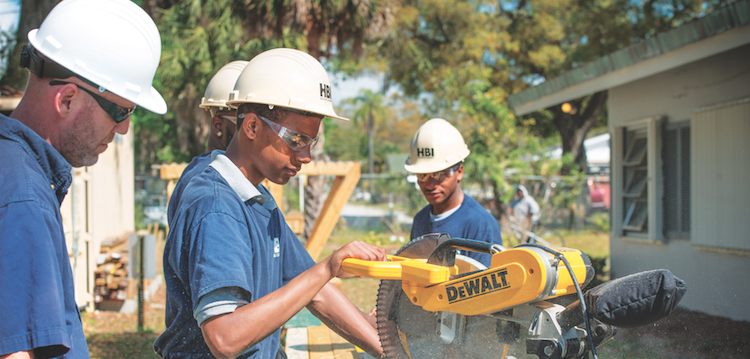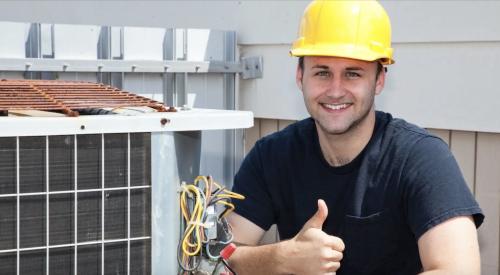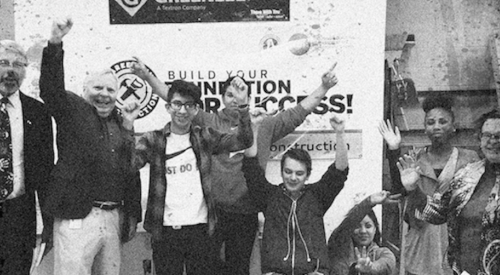What Is HBI?
For more than a year now my campaign to find concrete examples of how people or groups are attacking the nationwide trade shortage and seeing results has been disappointing, to say the least. But I have discovered some great examples and will feature more of them in future columns.
Media attention about the problem has grown, yet given the size of the industry, our generally meager efforts are nothing less than an embarrassment. Virtually everyone suffers under the trade shortage. We complain about it, yet few are willing to step up and do anything proactive to address it.
So, when a contact at the National Association of Home Builders directed me to HBI, my first question was, “What’s an HBI?” (And, it turns out, in a quick, informal poll I did of builders I know, most of them didn’t know either.)
HBI, the Home Builders Institute, is an organization that traces its roots back to the late 1940s. One click on the hbi.org homepage reveals the organization’s mission: “To advance and provide education, career development, training and placement of men and women serving the building industry,” and its vision: “To be the recognized source for career technical education in the building industry.” That sounds like something we should all know about.
HBI—a 501(c)(3) nonprofit—is a partner with the NAHB but officially independent from it. With 300 total staff members in 42 states, HBI is having considerable success. I spoke on the phone for an hour with Lynne Harris, VP of corporate communications, and John Courson, HBI’s president and CEO.
Soup to Nuts … and Then Some
The first shock to me was learning that HBI has 8,000 to 9,000 students in its programs at any given time, and that those programs can turn out a certified trade in 120 to 180 days. At that rate, HBI could process 20,000 to 25,000 students annually. The potential to add 250,000 trades to the base over a 10-year period has huge positive implications for the current trade shortage. That’s an average of 5,000 trades for each of the top 50 U.S. housing markets. The certifications are recognized by the U.S. Department of Labor, and 50 percent or more of the training is done in the field, so graduates have a pretty good idea of real-world jobsite conditions and requirements. At this time, HBI offers certification in the following important industry areas of need, with more to come:
- Brick masonry
- Building construction technology
- Carpentry
- Electrical wiring
- HVAC
- Landscaping
- Painting
- Plumbing
- Solar installation
- Weatherization
With 12 to 14 students per instructor, there’s little danger of participants getting lost in the system. But perhaps best of all, HBI places 85 percent or more of its students following program completion. Consider that for a moment. With just four to six months of training, a student can graduate into a high-demand, well-paying position. Compare that to, well, I can’t think of any career track to compare that to, can you?
John Courson adds, “We are the only group on a large scale that takes an interested student all the way through training and places them in a job.” He goes on to describe how HBI has long focused on underserved 16 to 24 year olds, many coming out of the military without a marketable skill, some who have had past trouble with the law, others even homeless. Now, if that gives you pause, I’ll ask you to pause a bit longer and think it through. My experience with these young people is that given support, a chance, and some training, most respond quickly, appreciate the opportunity, and make great employees. Add to that the societal benefits of getting young people into meaningful work instead of dependency, and the HBI proposition pays off on multiple fronts. The HBI website details a number of its success stories.
Working Miracles and Providing a Second Chance
One such case history that jumped out at me was Dakota Andekin, a former addict who was homeless and totally adrift. He “stumbled into” HBI’s Inland Empire Job Corps, trained as an apprentice plumber, took a job with a local company, then launched his own plumbing business. He is now a married homeowner and in a partnership with his brother; their Sewer Ninjas Plumbing firm just launched its second location. No surprise, Dakota is a frequent speaker for HBI Job Corps. Who wouldn’t want to hear that story? But a more important question for the Professional Builder audience, who wouldn’t want to support that story and be a part of it for other aspiring tradesmen and women?
Now try to imagine the reaction of the average builder—or anyone else—to hearing about a guy who is serving his fifth jail sentence for stealing to support a drug habit. Throw away the key, right? Some folks are just beyond rehabilitation. If you’d done that, however, you wouldn’t have Nate Coleman, who learned about HBI’s Pre-Apprenticeship Certification Program at the Sheridan Correctional Facility north of Chicago. Nate did so well in the program that he was quickly accepted into the regular masonry apprentice school. Fast forward to today and Nate is an instructor who absolutely loves his work training others. Can you imagine the impact his story has on other struggling young men and women? Nate made it, so they can, too.
Army veteran Leonard Thompson was coming off a four-year tour of duty in Iraq; a single parent desperately seeking a new path to support his daughter. Today, he’s a fairly typical success story for HBI’s Veterans Program. Leonard took a variety of HBI courses—including HVAC, electrical, and carpentry—and promptly found good employment as a metal fabricator. He’s now working toward becoming an underwater welder. With HBI’s help, the future for Leonard and his daughter looks bright. HBI now has programs on site at various military bases and is planning more.
These are just a few examples. Not all are as dramatic as the stories of Dakota, Nate, and Leonard, of course. For many, HBI simply provides a great alternative and better fit than going to college.
Solid Stuff: A Range of HBI Programs
You’ll be impressed by HBI’s detailed curriculum, including a series to train site superintendents, and will be inspired reading about some of HBI’s instructors. To cite just one example, HBI electrical instructor Josh Torres from the Roswell, N.M., Job Corps Center was recently named “Top Teacher of Character.” It’s noteworthy that HBI recognizes this critical aspect of teaching skills, and it’s a good bet that Josh’s students are getting their electrical knowledge down pat as well.
HBI makes it clear that—as well as providing job skills—character-building experiences that promote self-esteem and interpersonal skills that enable success in both work and in life are essential. In addition to the Job Corps, which focuses on at-risk youth at more than 70 sites, and the Veterans Program, which helps transition vets to good civilian jobs, HBI’s Pre-Apprenticeship Certificate Training (PACT) operates at more than 100 sites across the country. HBI students complete significant community-service projects as part of the hands-on training. One example recently completed by HBI students at the Tahlequah, Okla., Job Corps Center is Zoe House, a safe shelter for the area’s homeless. Another is a massive remodeling project of an old greenhouse into a new HBI workshop at the Cypress Creek Center, in Lecanto, Fla., that involved high-risk youth aged 13 to 21. It doesn’t take much research to predict that kids working together and learning building skills in this workshop was great for creating a positive outlook and offering hope for the future. One instructor, Justin Rosato, summed up the project, saying, “The students were overwhelmed with joy because of the knowledge they received during this training. It was hands-on, and they fell in love with it. ... Miracles were performed and memories created that’ll never be forgotten.”
To support all these programs, the HBI Residential Construction Academy has spent years developing an extensive and impressive series of residential construction skills standards-based textbooks and teaching aids. This is an ongoing effort with regular contributions from HBI instructors across the U.S.

What About the High Schools?
In John Courson’s President’s Message in the HBI Summer Quarterly (you can sign up for these on the website), he absolutely nailed one of the keys to progress on the trade shortage. While recently attending high school graduations for two of his grandsons, Courson noted, “I was struck at both ceremonies when school administrators gave special recognition to those going on to two- and four-year colleges and universities. I wondered, ‘What about those who are going on to the military or have earned trades credentials or other vocational training?’”
It’s tricky to pinpoint just how and when the tide turned against vocational training in this country, but it’s something against which we have to push back. This year, HBI is launching its Building Careers Program, a course for grades 9 through 12 that will provide industry-recognized credentials for graduates so they’re ready to work in construction trades. There are about 37,000 public and private high schools in the U.S. What if we could get a little over 10 percent of them to offer this program; let’s call it 4,000. And what if, on average, each school graduated 25 students per year in this program? That would provide 100,000 fresh, young workers for the industry annually. With some effort and the right people onboard, that number could dramatically increase in short order.
We’ve all seen statistics about the aging construction workforce. An immigrant population of younger workers in framing, drywall, concrete, and landscaping to name a few, holds down this average somewhat, but for skilled mechanical trades we often hear about average ages of 55 or older. What’s wrong with this picture? Add to that political trends toward making immigration—legal or otherwise—tougher, and home building is headed for a crisis. The trades aren’t jobs that people typically migrate to in their 30s or 40s after trying something more “white collar.” We have to get young men and women engaged early in their work careers. The HBI now has the tools to enable that at a much higher level.
Overcoming the Obstacles
At the end of my phone conversation with Courson, he emphasized that the primary obstacle here is funding. Go back to HBI’s website and look at its list of supporters—those who provide funding—and you’ll be struck by who’s missing. Most of the money comes via grants from foundations and government entities. Yet the parties that stand to gain the most from the work of HBI and other organizations that are actively developing trades are manufacturers, suppliers, home builders, and trade contractors themselves, yet few have engaged in the process upstream.
Yes, for individual companies, there is training once a new recruit is hired. But efforts to develop new prospects are meager, at best. I’m at a loss as to how that can be. Perhaps it seems too long-term. Yet Courson insists, “We can train any population in any location in our certified trade programs and be up and running in 90 days.” Add to that the time it takes to train, and if you made the decision on Oct. 1 to launch an HBI program or to support an existing one to a higher level, you could see graduates by May 1.
So here’s my challenge: If HBI isn’t in your market, get it there. If it is, support its growth. How hard should it be for builders, suppliers, and trades to join with their local HBA/BIA to make this happen? The knowledge and expertise is there, and you’ll soon see a return on any investment you make, as your local supply of quality trades grows. There’s also nothing wrong with helping your community and providing kids with a brighter future. Can you think of any better ROI?












